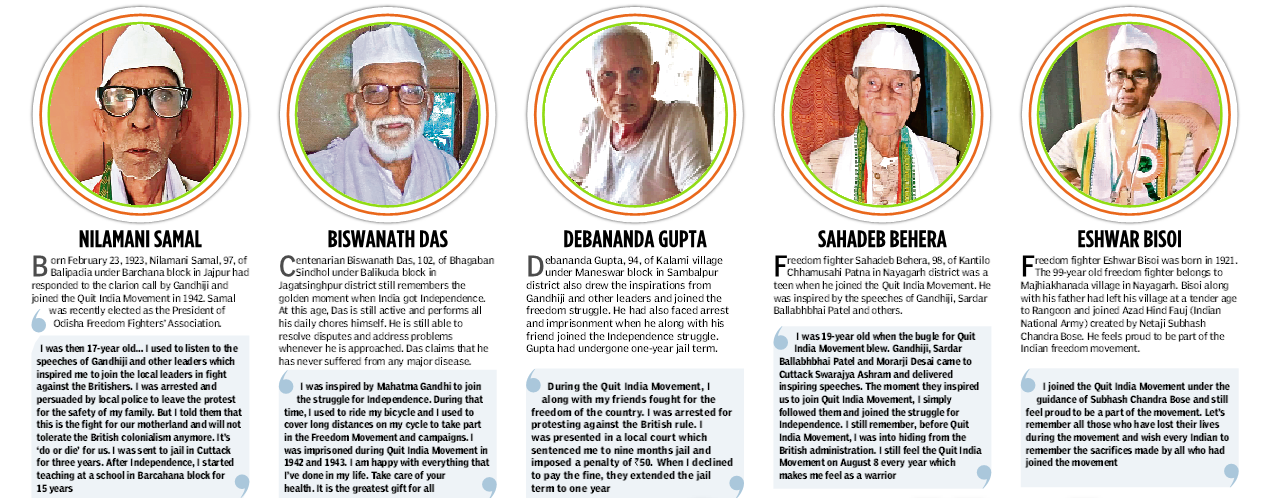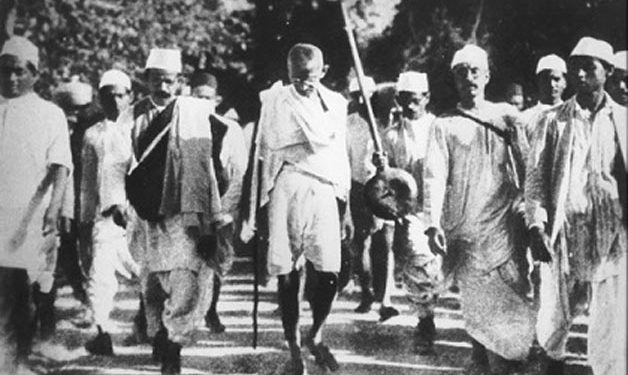When the Cripps Mission failed, Mahatma Gandhi August 8, 1942, made a call for ‘Do or Die’ in his Quit India speech delivered in Bombay at the Gowalia Tank Maidan. On the same day, at the All-India Congress Committee (AICC) session in Bombay, Gandhiji launched a resolution for the ‘Quit India’ movement. The next day, Gandhi, Jawaharlal Nehru and many other leaders of the Indian National Congress were arrested by the British Government. Disorderly and non-violent demonstrations took place throughout the country in the following days.
The AICC meeting held at Bombay to pass Quit India resolution was attended by five Odia leaders. They were Harekrushna Mahatab, Malati Chaudhury, Laxminarayan Mishra, Radhakrushna Biswasroy and Surendranath Dwivedy. Most of them were arrested at Bombay following Gandhi’s detention. When Surendranath Dwivedy met his private secretary at Birla Bhavan, he was handed over a small piece of paper containing a message by Gandhiji which read “Paralyse the administration. We are free from today, Be your own leader. Do or Die.” These words ignited the spirits of the people of Odisha to participate in the patriotic movement.

Cuttack was the nerve centre for the Quit India Movement in Odisha. The first response was from the students of Ravenshaw College. On August 12, the students of Ravenshaw College, led by Bhagirathi Mishra, Upendra Mohanty, Narasingha Tripathy, Biren Mitra, Durga Charan Mohanty and Manmohan Mishra, organised public meetings to condemn the arrest of Congress leaders by the Government. On August 14, under leadership of Banamali Patnaik, Ashok Das, Biren Mitra, Bibudhendra Mishra and Suraj Mal Saha, about 200 students entered the college premises and burned records and laboratories. Bibudhendra and Saha were later arrested and were confined in Behrampur Central Jail. The students had coined a term S.N.S. (Secret News Service) and notices and bulletins were circulated under this banner. Socialists under Surendran Nath Dwidey took lead and about 71 incidents of large-scale burning, loot and sabotage in various parts of Cuttack was reported during August.

Koraput was a partially excluded area and it was not administered by laws and regulations of the province. It was primarily noted for its tribal population who lived in the forest and hilly areas and its literacy rate was the lowest in the province. However, Laxman Naik, the ‘Gandhi of Malkangiri’ proved to be a hero of Quit India movement. By August 14, most of the Congress leaders of Koraput were in jail as the district Congress committee was declared illegal. Naik mobilised the tribals to offer stiff resistance to the British. On August 21, 1942, Laxman, along with 1,000 people, gheraoed the Mathili police station in Malkangiri. However, they were intercepted by the police and magistrate Mujibar Rahman gave orders to lathi charge and open fire. As a result of the encounter, five persons were killed and 17 were injured. Naik himself fell unconscious and lay by the side of the body of a forest guard who come to control agitators and was inadvertently shot by police.
The police oppression was most severe in Balasore district. At the beginning of the movement, some prominent Congress leaders were arrested. On August 17, 1942, a mob of about 5,000 armed men invaded the police station in Bhandaripokhari village and injured a police official, smashed the furniture and tore records in the police station. However, the movement took a turn for the worse at the Bhadrak sub division. On September 28, 1942, people gathered at an open place at Eram and resolved not to pay tax. So, the police came to arrest some leaders. When the police arrived, people started blowing conches and about 5,000 people armed with lathis gathered. As the ‘choukidars’ were carrying the luggage of police officials to the residence of a Zamindar, two satyagrahis Ratnakar Biswal and Mani Bej snatched them away by saying “You cannot carry the belongings of the British Government.” Over this, DSP Kunja Bihari Mahanty was enraged and ordered open fire on the mob at Melan Ground. Official reports said that about 26 persons were killed and 54 persons were injured. Later the police unleashed a reign of terror over Eram and surrounding villages.
The Puri district was comparatively quiet during the movement. Sulakshana Mali Jema, wife of zamindar of Manijong, initiated the movement by proposing to occupy the police station of Nimapara. A meeting was held September 16 to discuss the plan at Barabati Field. Agitators proceeded towards the police station and pelted stones at the police force. Ucchab Mallick, a dalit agitator, made efforts to break the police cordon following which the police fired upon the people leading to death of Ucchab and injury to 16 others. Hereafter, the police arrested 41 persons including Bhabani Patnaik, Gajendra Malik (son of Uchhab Mallick), Padma Charan Samantasinghar, Pitabas Sahu and many others.
Maximum cases of revolutionary activities were reported in Jajpur subdivision of Cuttack district. The revolutionary mob at Jajpur set afire police uniforms in twenty six places, six canal revenue offices, four post-offices, five excisable articles, six zamindari Kutcheries, and four PWD bungalows in August 1942. The violent mob started burning various government offices and cut down the embankments, canals and telegraphs lines in different areas of Jajpur. In Binjharpur, a violent mob attacked police persons when the latter were escorting some prisoners. The mob was dispersed after police firing. In some villages, young men formed defence associations for fighting against police oppressions in their areas. A mob of 10,000 in the Jajpur town proceeded towards the police station and SDO’s August 27, 1942. The mob was dispersed by the armed force by dropping dynamites on the people.
Laxminarayan Mishra attended the AICC meeting at Bombay in August 1942. On his return, he was arrested and Zilla Congress committees of Sambalpur, Bargarh and Jharsuguda were declared illegal. Anti-British demonstrations were held and hartals were observed. Important freedom fighters such as Nrusingha Guru, Dayanidhi Satapathy and Ramarakshya Sukla were arrested under Defence of India Act. Women activists also took out rallies in Bargarh town.






































